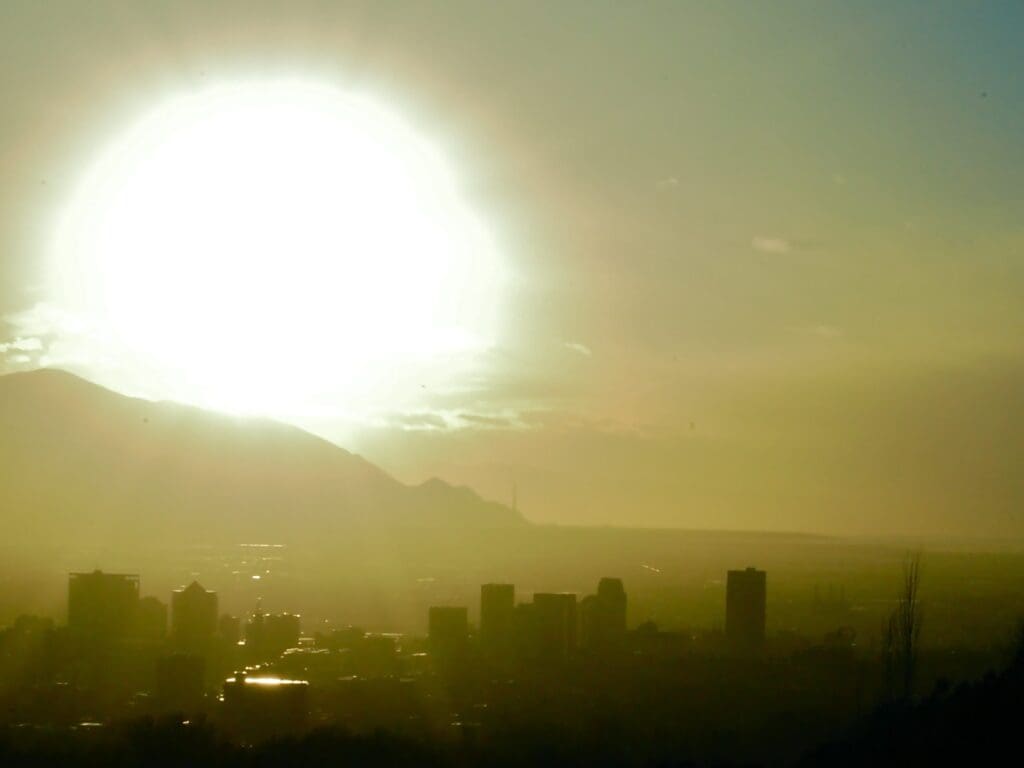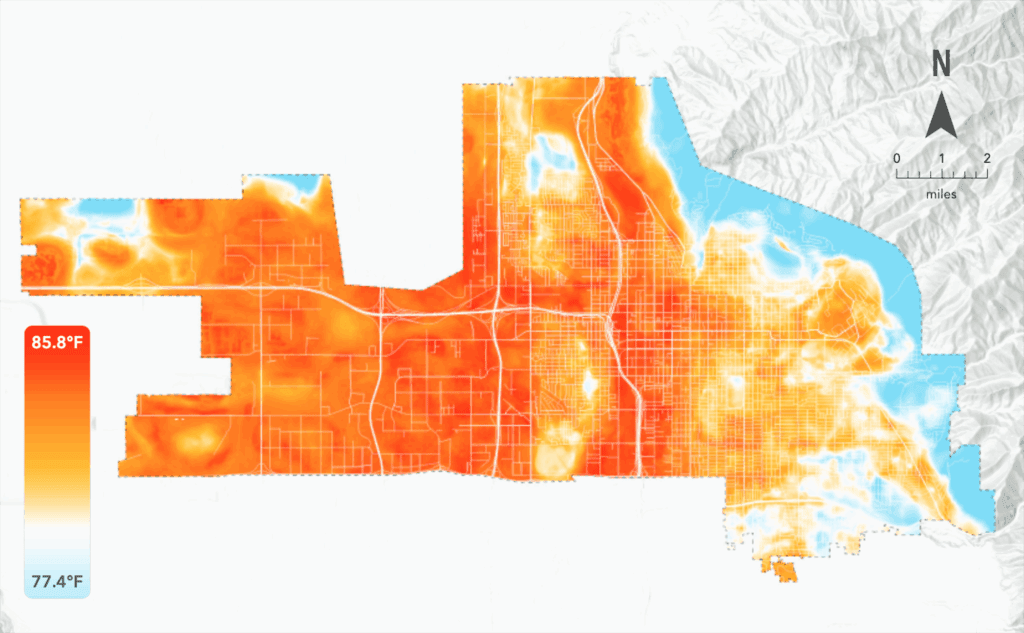
As the summer heat continues, it’s important to understand how to deal with extreme temperatures and why they are becoming more frequent every year. We have seen Salt Lake County’s average summer temperature increase by 3.9° F since 1985, while the U.S. average has increased by 1.5°F.
What is the Urban Heat Island Effect?
Have you ever noticed how the city feels much hotter than surrounding areas? That feeling is thanks to the urban heat island effect. The heat island effect is a phenomenon that leads to higher temperatures in urban areas compared to rural areas. This temperature difference is due to the greater presence of heat-absorbing surfaces, like large buildings and pavement, and not as much vegetation and green space in a city. The high density of buildings within cities also makes it harder for temperatures to decrease at nighttime.
How is Heat Distributed in SLC?
In a 2015 study, the Salt Lake metro area exhibited the most intense urban heat island out of 50 cities across the country. But higher temperatures are not felt equally across Salt Lake City. After conducting a heat mapping campaign in 2023 with leadership from CAPA Strategies and funding from the National Oceanic and Atmospheric Administration (NOAA), it became clear that some neighborhoods across the city are hotter than others. Neighborhoods west of the I-15 like Poplar Grove, Glendale, and Fairpark experience temperatures on average 8°F higher than many neighborhoods on the east side of the I-15 like the Avenues, Wasatch Hollow, and Yalecrest. Other hotspots exist throughout the city as well, in areas like the University of Utah, along Foothill Drive, and Downtown along State Street. These areas are covered mostly by pavement, which has limited cooling effects.

It’s important to recognize that the unequal distribution of heat across the city often corresponds with previously redlined areas. Redlining was a historical practice that designated certain areas of the city as desirable and other areas as less desirable for home loans and mortgages. Areas marked as less desirable were often home to greater minority populations and it was harder for those groups to receive benefits from homeownership programs. These neighborhoods were not targeted for investments or renovations, and now, they still lack green space and are host to more industrial sites, major transportation infrastructure, and overall, more pavement—all of which contribute to higher urban temperatures.
But trees and green space do make a difference – across all areas of Salt Lake City. The heat mapping campaign from 2023 shows the powerful cooling effects of trees everywhere from Yalecrest and Sugar House to Poplar Grove and Glendale. And our very own staffer, Carolina Gomez-Navarro, studied the urban heat island and green infrastructure as part of her PhD. She found that vegetated parks were up to 2 degrees cooler than surrounding residential areas. In particular, turf grass, especially when paired with trees, does play an important cooling role, but it needs to be used strategically (like in parks and high-use spaces).
Negative Impacts of Heat
Extreme heat impacts many aspects of life including our health and the economy. Prolonged exposure to high temperatures can lead to heat exhaustion or heat stroke, dehydration, and muscle fatigue. These hot temperatures also speed up the reaction between nitrogen oxides (NOx) and volatile organic compounds (VOCs), the chemicals from our cars that form ozone pollution. The Salt Lake City-Provo-Orem area recently ranked No. 9 in the country (again) for ozone pollution, leading to more cases of asthma and other respiratory issues.
Additionally, trying to work while experiencing extreme heat is difficult, leading to productivity losses that impact our economy. Heat also puts a greater strain on our energy grid, and we have to spend more money on cooling.
What is the City Doing About It?
While there is much more that needs to be done, the City has been prioritizing changes to the landscape code, as well as focusing on adding more trees to neighborhoods. You may have seen the outreach campaign publicizing the City’s landscaping guidelines around artificial turf and other measures. Artificial turf is a problem for UHI because it absorbs and radiates heat back in the neighborhood. It also contaminates groundwater with microplastics and other toxins, and increases the risk of flooding.
Furthermore, in its landscaping code updates last year, the City clarified that rock mulches and hard surfaces can only cover a maximum of 20% of a park strip, front, or side yard, while also setting the standard that 33% needs to be covered with certain types of waterwise vegetation. In park strips wider than 36 inches, at least one street tree is required. All of these landscaping updates were made to balance the needs of water conservation, environmental health, and the importance of reducing urban heat.
Additionally, the Mayor has continued her focus on the importance of planting trees. In the past six months, Mayor Mendenhall has planted 1,850 trees, and over 5,000 trees have been planted on the Westside since 2020 in an effort to combat historical injustices. We can see from our heat mapping project that trees have been successful in cooling down temperatures in many different neighborhoods. The Mayor’s proposed Capital Improvement Project budget, which awaits final City Council approval in August, also sets aside $3 million for the first phase of the Green Loop, with the goal of bringing more urban green space to the Downtown area and cooling down our streets. Feasibility studies will also be conducted for other routes on the Green Loop later this year.
Construction on Pioneer Park is expected to start this fall too, bringing a 29% increase in the number of trees and a new water feature to keep visitors cool. Additionally, construction is currently underway on Glendale Regional Park, a new park on the Westside that will include water features and access to the Jordan River for activities like kayaking and paddleboarding, while also providing more tree cover for visitors. The park will be SITES certified too, meaning that it will achieve multiple sustainability and restoration goals.
How You Can Stay Cool
If you’re worried about staying cool this summer, follow these tips!
- While indoors…
- Avoid cooking with the oven or stove.
- Avoid drinks with alcohol and caffeine.
- Close window shades during the day.
- Eat lighter foods.
- Take cool showers.
- While outdoors…
- Wear lightweight clothing.
- Drink a lot of water.
- Take breaks in shaded areas.
- Wear sunscreen and a hat.
- Do physical activity in the early morning or late evening.
- While saving money…
- Set air conditioning between 75°F and 78°F to stay cool and save money. Supplement with fans when possible to improve comfort and reduce the need to crank up the a/c.
- Use sheets or blankets to cover windows during the day.
- Visit one of Salt Lake County’s designated cooling centers to escape the sun.
- Open windows on opposite walls to circulate air in the early morning and late evening.
If you start to experience any heat-illness symptoms like heavy breathing, hot and dry skin, nausea, headache, and muscle cramps, make sure you move to a cool or shaded area immediately and call for help if necessary. Keep an eye on your friends and neighbors, and check on those you know don’t have air conditioning!
Looking Toward Inspiring Cities
If you are interested in seeing what the future of Salt Lake City’s urban heat mitigation efforts could look like, check out these inspiring cities across the world!
New York City launched the Cool Neighborhoods Plan which includes targeted tree planting, incentives for cool roofs, and the Be a Buddy Program.
Los Angeles created a resiliency plan that will develop a heat vulnerability index, test cost-effective cooling strategies, and expand their network of cooling centers.
Sydney, Australia developed the Heat Smart City Plan with 40 recommendations for building up resiliency in residences, buildings, infrastructure, and the economy.
